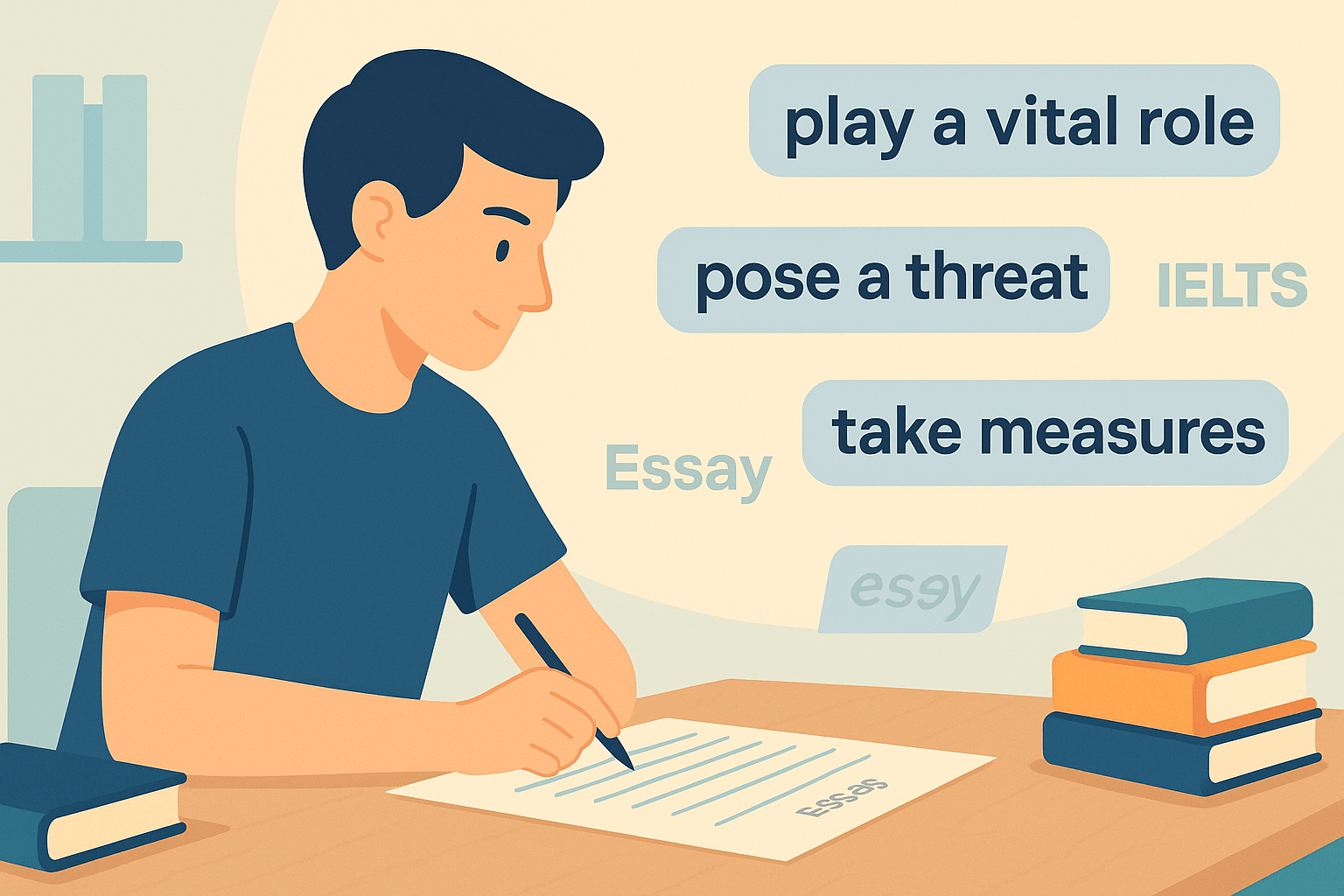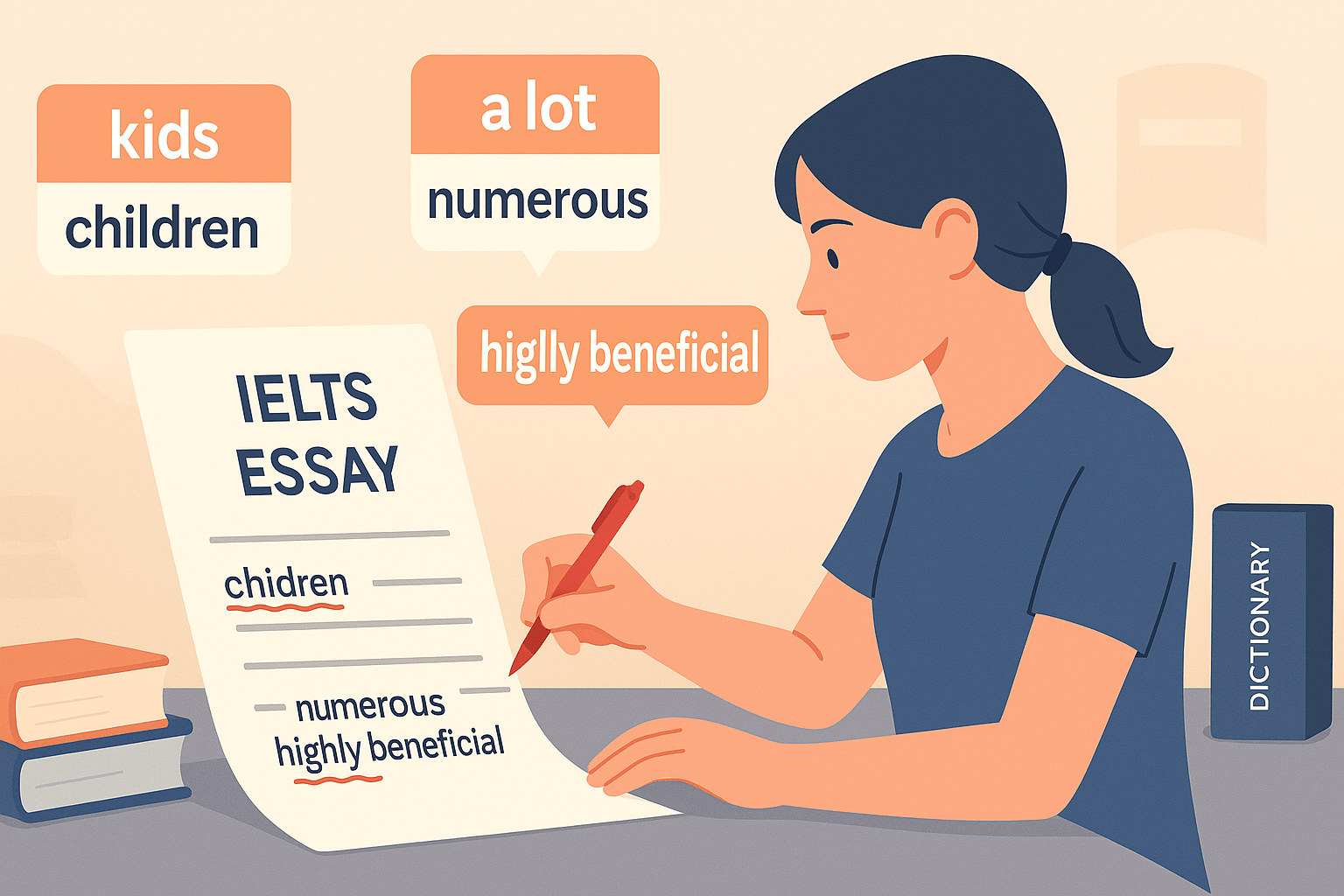When I teach IELTS Writing Task 2 to students across the globe, one question comes up repeatedly:
“How can I make my essay sound natural, cohesive, and Band 9 ready?”
The answer is collocations and formal expressions.
IELTS collocations for writing task 2 are word pairs or phrases that native speakers naturally use together. When you master them:
- ✅ Your writing sounds fluent and academic
- ✅ You avoid awkward or repetitive language
- ✅ Your Lexical Resource score improves
In this guide, I’ll share Band 9 collocations and expressions for common IELTS essay topics and structures, along with teacher tips to use them effectively.
Before you begin, I recommend my IELTS Writing Task 2 Vocabulary for Band 7–9—it’s the pillar resource for academic writing words and connectors.
Why Collocations and Expressions Matter for Band 9
IELTS examiners look for natural, formal English in your essay. Using collocations:
- Makes your writing sound fluent and cohesive
- Helps you avoid translation-like sentences
- Boosts Lexical Resource, a core scoring criterion
For official guidance, visit:
IELTS Collocations for Writing Task 2: Band 9 Expressions
Here’s my teacher-approved list of high-level collocations and expressions that will make your essay sound natural and examiner-friendly.
1. Collocations for Expressing Opinions
Opinion essays (agree/disagree) require formal and confident expressions:
- play a vital role
- is widely believed that
- it is my firm conviction that
- there is a strong argument for
- I am inclined to believe that
Example:
“Education plays a vital role in shaping an individual’s career and contributing to national development.”
2. Collocations for Advantages and Disadvantages
When discussing pros and cons, use collocations instead of basic words:
- bring about benefits
- pose a threat to
- create opportunities for
- have a detrimental effect on
- outweigh the drawbacks
Example:
“While social media creates opportunities for global communication, it also poses a threat to privacy.”
3. Collocations for Problem and Solution Essays
Use problem-solving language to sound formal and structured:
- address the issue
- take effective measures
- implement solutions
- tackle the root cause
- prevent further damage
Example:
“Governments must take effective measures to tackle the root cause of urban traffic congestion.”
4. Collocations for Cause and Effect Essays
Band 9 essays often link causes to effects with natural collocations:
- give rise to
- result in
- have an impact on
- lead to the emergence of
- is responsible for
Example:
“Deforestation gives rise to habitat loss, which has a severe impact on biodiversity.”
5. Collocations for Academic Evaluation
When analyzing issues, use evaluative expressions:
- play a significant part in
- from an economic perspective
- in the long run
- in terms of impact
- has far-reaching consequences
Example:
“Renewable energy investment has far-reaching consequences for environmental sustainability and economic growth.”
Teacher Tips: Using IELTS Collocations for Writing Task 2 Effectively
To maximize your Lexical Resource score, follow these tips:
1. Learn Collocations by Topic
Instead of memorizing random word lists, group collocations by essay type:
- Environment → reduce emissions, promote sustainability
- Education → enhance learning outcomes, provide equal opportunities
2. Combine Collocations with Linking Words
Cohesion improves when collocations connect logically with ideas:
“Globalization creates opportunities for economic growth. However, it may also pose a threat to cultural diversity.”
3. Avoid Overusing Complex Expressions
Some students think fancy words = Band 9, but examiners prefer clarity + natural flow.
❌ “Urbanization catalyzes multifarious ramifications of social disparity.”
✅ “Urbanization gives rise to social inequality and economic challenges.”
Sample Paragraph Using IELTS Collocations for Writing Task 2
“Global warming has a detrimental effect on both natural ecosystems and human health. Rising sea levels pose a threat to coastal cities, and deforestation gives rise to biodiversity loss. To address the issue, governments must take effective measures, including promoting sustainable energy use and enforcing environmental laws.”
Notice how the paragraph:
- Uses collocations naturally
- Maintains a formal, academic tone
- Shows cause, effect, and solution connections
Quick Practice Exercise
Rewrite this informal sentence using IELTS collocations for writing task 2:
“Lots of cars in cities are bad for health and the environment.”
Suggested Answer:
“The excessive number of private vehicles in cities has a detrimental effect on public health and the environment.”
FAQ Section
Q1: What are IELTS collocations for writing task 2?
They are natural word combinations like “pose a threat to” or “take effective measures” that make essays sound fluent and academic.
Q2: Why are collocations important for Band 9 essays?
Collocations improve Lexical Resource and cohesion, making your writing examiner-friendly and natural.
Q3: How many collocations should I use in one essay?
Use 5–10 well-placed collocations naturally across your essay—avoid forcing them.
Conclusion
Mastering IELTS collocations for writing task 2 is a game-changer for Band 7–9 writing.
When you:
- Use natural collocations and formal expressions
- Combine them with cohesive connectors
- Maintain clarity and logical flow
… your essay will sound fluent, academic, and examiner-approved.
🔗 Next step: Strengthen your essay writing by reviewing our IELTS Writing Task 2 Vocabulary for Band 7–9 and integrating collocations into your practice essays.





